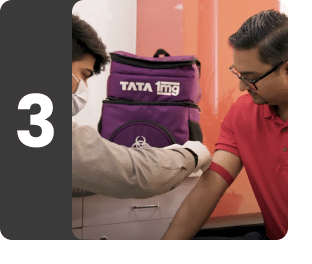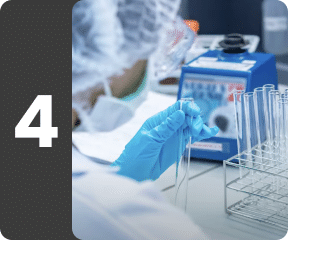Fever Package Comprehensive near me in Hyderabad
Understanding Fever Package Comprehensive in Hyderabad
What is Fever Package Comprehensive in Hyderabad?
Fever comprehensive package offers tests that can help identify some common causes of fever like dengue, malaria, typhoid, chikungunya, infections or illness. These tests are advised if the fever is persistent and the cause is not identified. The doctor may advise these tests if you have been suffering from fever for a long time and experiencing symptoms like weakness, tiredness, loss of appetite, irritability, body ache and headache. These tests help detect the cause of fever as the untreated causes may pose serious health complications. Timely identification of the cause of the fever may help the doctor in prompt treatment planning.
What does Fever Package Comprehensive measure?
Contains 43 tests
Erythrocyte Sedimentation Rate
The ESR test measures the rate at which red blood cells (erythrocytes) settle (sediment) at the bottom of a tube that contains a blood sample in one hour. The test result is expressed in millimeters per hour (mm/hr).
In the presence of inflammation, certain proteins mainly fibrinogen increase in blood. This high proportion of fibrinogen in the blood causes the red blood cells to form a stack (rouleaux formation) which settle quickly due to their high density.
The ESR test is a non-specific measure of inflammation. An ESR can be affected by conditions other than inflammation also. Although a high ESR can detect the presence of inflammation, it cannot provide any information regarding the cause and site of inflammation. Hence, an ESR test is done along with other tests.
Know more about Erythrocyte Sedimentation Rate

Dengue NS1 Antigen
Dengue virus is a flavivirus with four distinct serotypes (Dengue virus 1, 2, 3, and 4). It is primarily transmitted by the Aedes aegypti mosquito, found in the tropical and subtropical regions.
Dengue nonstructural protein 1 (NS1) is an antigen produced by the replicating dengue virus. These antigens can be detected as early as the first day of symptoms and as late as day 18 of symptoms.
Clinically, in the beginning, there is sudden onset of fever combined with headache, muscle and joint pains (severe pain that gives it the nickname break-bone fever or bone crusher disease), distinctive pain from behind the eyes (retro-orbital pain) and rash (a generalized maculopapular rash with islands of sparing). After that, a hemorrhagic rash of characteristically bright red pinpoint spots (known as petechiae) can occur during the illness which is associated with thrombocytopenia. It usually appears first on the lower limbs and the chest, however, in some patients, it spreads to most of the body. Along with that, there can also be gastritis (inflammation in the stomach lining) with associated stomach pain, nausea (feeling sick), vomiting coffee-grounds-like congealed blood or diarrhea.
Dengue Hemorrhagic fever (DHF):
In DHF, the fever can go to a higher grade, it might also include variable bleeding manifestations like bleeding from the eyes, nose, mouth, ear and oozing blood from skin pores. Other bleeding manifestations include thrombocytopenia, and hemoconcentration (thickening of the blood).
Dengue hemorrhagic fever is a leading cause of serious illness and death among children. There is no specific treatment for dengue, but appropriate medical care can save the lives of patients with the more serious dengue hemorrhagic fever.
Know more about Dengue NS1 Antigen

Complete Blood Count
Blood Stag is composed of blood cells suspended in blood plasma (yellowish-colored liquid). The blood cells include red blood cells (also called RBCs or erythrocytes), white blood cells (also called WBCs or leukocytes), and platelets (also called thrombocytes).
Red blood cells (RBCs) are the most abundant blood cells. RBCs contain hemoglobin which helps in the transportation of oxygen to the tissues. RBC count is the measurement of the number of RBCs in a given volume of blood.
Packed Cell Volume (PCV) or Hematocrit (Hct) is the measurement of the blood volume occupied by RBCs. It is expressed in percentage.
White blood cells (WBCs) are key components of the immune system and thus protect the body from various infections and cancers. Total Leucocyte count (TLC) is the measurement of the total number of leukocytes (WBCs) in a given volume of blood.
There are five types of WBCs:
-
Neutrophils
-
Basophils
-
Eosinophils
-
Lymphocytes
-
Monocytes
Differential Leucocyte Count (DLC) determines the percentage of different types of WBCs.
Neutrophils, Basophils, and Eosinophils are called Granulocytes because of the presence of granules inside these cells.
Absolute count of different types of WBCs is the measurement of their absolute numbers in the given volume of blood.
Platelet count - Platelets (also called thrombocytes) are disc-shaped cell fragments without a nucleus that help in blood clotting. Platelet count is the measurement of the number of platelets in a given volume of blood.
Mean Platelet Volume (MPV) is a measurement of the average size of platelets.
PDW or platelet distribution width refers to the variation of platelet size distribution
Hemoglobin (Hb) - Hemoglobin (Hb) is a protein found in red blood cells (RBCs) that carries oxygen from the lungs to the body tissues, exchanges the oxygen for carbon dioxide, and then carries the carbon dioxide back to the lungs where it is exchanged for oxygen.
Mean Corpuscular Volume (MCV) is the average volume of a red blood cell.
Mean Corpuscular Hemoglobin (MCH) is the average amount of hemoglobin in the average red blood cell.
Mean Corpuscular Hemoglobin Concentration (MCHC) is the average concentration of hemoglobin in a given volume of red cells.
Red Cell Distribution Width Coefficient of variation (RDW CV)is a measurement of the variability of the red blood distribution curve and their mean size.
Know more about Complete Blood Count
PDW
RDW CV
Absolute Lymphocyte Countx
Absolute Neutrophil Count
It gives us a measure of one of the components of the white blood cells , called Neutrophils. While all white blood cells help your body fight infections, neutrophils are important for fighting against bacterial infection.
Differential leucocyte Count
- Differential Neutrophil Count
- Differential Lymphocyte Count
- Differential Monocyte Count
- Differential Eosinophil Count
- Differential Basophil Count
Blood is made up of different types of cells which are suspended in a fluid called plasma. These include erythrocytes or red blood cells, leukocytes or white blood cells, and platelets. Blood cells are produced by the hematopoietic cells in bone marrow and are then released into circulation. RBCs carry oxygen to the tissues, platelets help in blood clotting at a site of injury, and leukocytes form an integral part of the immune system of the body.
WBCs are of five types, each having a different function and present in different numbers:
1. Neutrophils: Under normal conditions, the number of neutrophils present is higher than any other type of WBCs.. They provide protection against pathogens, mostly bacteria and sometimes fungi. Neutrophils engulf the pathogens completely and digest them (the process is called phagocytosis). They are usually associated with acute or short-term infections.
2. Eosinophils: Eosinophils are WBCs that are primarily responsible to fight parasitic infections. They are also involved in allergic reactions and regulation of the extent of immune response.
3. Basophils: Basophils are WBCs which are present in the lowest numbers in circulation. They are considered to play an important role in allergic response.
[Neutrophils, eosinophils, and basophils are together classified as granulocytes. Granulocytes are the WBCs which contain granules present in their cytoplasm. These granules secrete chemicals during immune response.]
4. Monocytes: Monocytes are WBCs which are also involved in protection against infectious pathogens by phagocytosis like neutrophils. However, monocytes are more commonly associated with chronic or long-term infections.
5. Lymphocytes: These are specialized WBCs which are responsible for recognizing and neutralizing foreign (non-self) cells and cancer cells in the body. Lymphocytes are of three types, all of which are differentiated from a common type of lymphocyte progenitor cell:
· T cells or T lymphocytes are produced in the bone marrow and mature in the thymus gland. They are responsible for differentiating between self and non-self cells of the body. T cells are also responsible for the initiation and extent of immune response, and targeted destruction of cancer cells and virus.
· B cells or B lymphocytes are control acquired immunity by producing antibodies against antigens found on foreign cells and pathogens like bacteria and viruses.
· Natural killer cells or NK cells destroy all foreign cells tagged by antibodies, cancer cells and virus-infected cells by phagocytosis.
Depending on various factors like age, gender, health condition, environmental factors, etc., varying amounts of different types of WBCs circulate in the blood. The bone marrow increases production of WBCs in response to an infection or inflammation anywhere in the body, which are then called to the site by a series of chemical signals, where they work to treat the condition. Depending on the condition, the count of one or more types of WBCs remains high in the blood. Once the condition subsides, WBC production by the bone marrow decreases and their count in circulation falls back to normal levels. Elevated amount of one or more types of leukocytes for a long time may be an indication of a chronic condition that is not resolving naturally and might need urgent attention.
Apart from an infection or inflammation, WBC count in blood can also be affected by other conditions like disorders of the immune system, autoimmune conditions, cancer, etc. One or more types of WBC count may be higher or lower than normal in these cases.
Differential Leukocyte Count Test serves as an indication of a condition affecting the body. Further tests are performed to confirm a particular condition and direct treatment.
This further contains
Red Blood Cell Count
Hemoglobin
The hemoglobin test measures the amount of hemoglobin in the blood.
Hemoglobin (Hb) is a protein found in red blood cells (RBCs) that carries oxygen from the lungs to the body tissues, and to exchange the oxygen for carbon dioxide. Hemoglobin then carries the carbon dioxide back to the lungs and where it is exchanged for oxygen. Iron is an essential part of hemoglobin. Most blood cells, including red blood cells, are produced regularly in your bone marrow (present within the cavities of many of large bones). To produce hemoglobin and red blood cells, your body needs iron, vitamin B12, folate and other nutrients from the foods you eat.
A decrease in hemoglobin concentration in blood results in anemia. Anemia is a blood disorder characterized by a decrease in the total amount of red blood cells (RBCs) or hemoglobin in the blood or a lowered ability of the blood to carry oxygen to body organs and tissues. Anemia is the most common blood disorder, affecting about a third of the global population and can cause symptoms like tiredness (fatigue), weakness, shortness of breath etc.
The hemoglobin test is usually performed as a part of complete blood count (CBC) test.
Platelet Count
The platelets will adhere to the injury site
The platelets will accumulate at the injury site
The platelets will release chemical compounds which stimulate gathering of other platelets
The platelet count measures the number of platelets present in the blood. Platelets are also known as thrombocytes which are tiny fragments of cells. These are formed from large cells which are found in the bone marrow known as megakaryocytes. After the platelets are formed, they are released into the blood circulation.
Whenever there is an injury to a tissue or blood vessel, bleeding starts. At this point, platelets help in stopping the bleeding in three ways:
With these steps, a loose platelet connection forms at the site of injury. This process is known as primary hemostasis. The activated platelets start to support the coagulation cascade which involves a series of steps that includes the sequential activation of clotting factors. This process is known as secondary hemostasis which results in the formation of fibrin strands that knit through the loose platelet connection to form a fibrin net. After that, the connection is compressed to form a stable clot so that it remains in place until the injury heals. Once the injury is healed, other factors come into play and break it down so that it gets removed.
In case the platelets are not sufficient in number or are not functioning properly, a stable clot might not form. These unstable clots can result in an increased risk of excessive bleeding.
Total Leucocyte Count
Blood is made up of different types of cells suspended in a fluid called plasma. These include erythrocytes or red blood cells, leukocytes or white blood cells, and platelets. Blood cells are produced by the hematopoietic cells in bone marrow and are then released into circulation. RBCs carry oxygen to the tissues, platelets help in blood clotting at a site of injury, and leukocytes form a part of the immune system of the body. WBCs are of five primary types: neutrophils, basophils, eosinophils, monocytes, and lymphocytes. Lymphocytes are further of three types: B-Lymphocytes, T-Lymphocytes, and natural killer (NK) cells. Neutrophils, basophils, eosinophils are collectively called granulocytes since they contain granules in cytoplasm.
Depending on various factors like age, gender, health condition, environmental factors, etc., varying amounts of different types of WBCs circulate in the blood. The bone marrow increases the production of WBCs in response to an infection or inflammation anywhere in the body. These WBCs are called to the site by a series of chemical signals, where they work to treat the condition. During this time, the total leukocyte count remains high in blood. Once the infection or inflammation subsides, WBC production by bone marrow decreases and WBC count in circulation falls back to normal levels. A continuously elevated WBC count may thus be an indication of a chronic condition that is not resolving naturally and might need urgent attention.
Apart from an infection or inflammation, WBC count in blood can also be affected by other conditions like disorders of the immune system, autoimmune conditions, cancer, etc. WBC count may be higher or lower than normal in these cases.
WBC count test serves as an indication of a condition affecting the body. Further tests are performed to confirm a particular condition and direct treatment.
Absolute Basophil Count
Absolute Monocyte Count
Absolute Eosinophil Count
The absolute eosinophil count measures the number of eosinophils present in the blood. Eosinophils, a type of white blood cells, helps in fighting the disease. These come into action for are said to be linked with certain infections and allergic diseases. The eosinophils are produced and mature in the bone marrow. They usually take about 8 days to mature and then are moved to blood vessels.
The eosinophils have varied functions which include the physiological role in organ formation such as the development of post-gestational mammary gland. Other functions include its movement to the areas of inflammation, trapping substances, killing cells, bactericidal and anti-parasitic activity. It also helps the treatment of immediate allergic reactions and modulation of inflammatory responses.
Hematocrit
Human blood is made up of erythrocytes or red blood cells, leukocytes or white blood cells, and platelets suspended in a fluid called plasma. Each of the component of blood performs a specific function. The packed cell volume or hematocrit is a ratio of the volume occupied by the RBCs to the total volume occupied by all the blood components or whole blood.
The RBCs transport inhaled oxygen from the lungs to all the cells of the body, and also a small amount of carbon dioxide from the cells to the lungs to be exhaled. The majority of carbon dioxide is transported in solution in plasma as bicarbonate ions. They contain a protein called hemoglobin which binds to oxygen for transport.
RBCs are produced in the erythropoietic cells of the bone marrow in response to the hormone Erythropoietin secreted by the kidneys when oxygen saturation of blood is detected to be low (hypoxia). The average lifespan of RBCs in circulation is 120 days. Hence, the bone marrows continuously produce RBCs to maintain a steady concentration in blood. The Packed Cell Volume Test depends on the count as well as the average size of the RBCs (Mean Corpuscular Volume or MCV). Higher than normal amount of RBCs produced by the bone marrow can cause the hematocrit to increase, leading to increased blood density and slow blood flow. Lower than normal hematocrit can be caused by low production of RBCs, reduced lifespan of RBC in circulation, or excessive bleeding, leading to reduced amount of oxygen reaching the cells.
Mean Corpuscular Volume
Mean Corpuscular Hemoglobin
Mean Corpuscular Hemoglobin Concentration
Mean Platelet Volume
GT New Test 2 added organ and changed name sample 45
utt

C- Reactive Protein Quantitative
CRP Test measures the levels of CRP in blood to detect the presence of an inflammation or to monitor the treatment and progress of an inflammatory condition. C-reactive Protein or CRP is an acute phase reactant protein which is produced and secreted by the liver in response to an inflammation in the body, which may be caused by tissue injury, infection, or autoimmune diseases. CRP levels increase in patients with trauma, heart attack, autoimmune diseases, bacterial infections, sepsis, post surgery, cancer, etc. CRP levels are often increased before the onset of other symptoms of inflammation such as pain, fever, etc. CRP levels in blood fall as the inflammation subsides.
It is a non-specific test. It can neither diagnose a condition by itself nor can it determine the location of a particular inflammation or disease. Other tests along with physical examination are performed to diagnose a particular condition and determine the location.
A variant of the CRP test is the High Sensitivity C-reactive Protein Test (hs-CRP) which is more sensitive for CRP levels and can detect blood CRP levels at a lower concentration than the standard CRP Test. The hs-CRP Test is performed usually to determine the risk of development of cardiovascular diseases in otherwise healthy individuals.
Know more about C- Reactive Protein Quantitative

Malarial Antigen (Vivax & Falciparum) Detection
The Malarial Falciparum and Vivax antigen test is a rapid diagnostic test which detects the presence of malarial antigen in the blood sample. Malaria is an infectious disease which is caused by a species of Plasmodium parasite. It is transmitted by the bite of an infected mosquito (female anopheles). The species which cause infections in humans include Plasmodium Vivax, Plasmodium malariae, Plasmodium ovale, and Plasmodium falciparum.
This malarial infection may rarely pass from a woman to her baby during pregnancy, labor, or delivery. Also, the chances of the spread of infection are very low through blood transfusion, sharing of contaminated needles or syringes, and organ transplant.
When an infected mosquito bites a person, the parasites enter into the blood and travel to the liver. After a person is infected it takes about 7-30 days for the eggs to mature. The parasites enter the red blood cells of a person where they multiply inside these cells. These cells burst within 48 to 72 hours which leads to the occurrence of symptoms of malaria.
The disease can relapse in case the infection is caused by P. vivax and P. ovale species. This is because these parasites can remain inoperative in the liver before they enter again into the blood and may take up to months and even years for the symptoms to appear.
If the malarial infection is not treated, it can cause severe illness and even death. The species likely to cause life-threatening disease is P. falciparum.
Know more about Malarial Antigen (Vivax & Falciparum) Detection

Widal Test (Slide Agglutination)
The Widal test measures the titres of antibody against the bacteria which cause Enteric fever.
Typhoid and paratyphoid fever are generally acquired when you consume food or water, contaminated by feces of an acutely infected or convalescent person (recovering from disease) or a chronic, asymptomatic carrier. The incubation period (the time interval between exposure to an infection and the appearance of the first symptoms) of Enteric fever is 6-30 days. Paratyphoid fever is similar but often less severe than typhoid fever.
Widal test is an agglutination test to detect antibodies (agglutinins) in a blood sample against two antigens (O & H) of bacteria, Salmonella enterica. Agglutination refers to the visible clumping of particles when a particulate antigen combines with its antibody in the presence of optimum conditions for antigen-antibody reaction. When this test is performed on a slide, it is called Slide agglutination and when it is carried out in a test tube, it is called Tube agglutination. Widal test by Tube agglutination is recommended over Slide agglutination method. The antigens used in the test are “H” and “O” antigens of Salmonella Typhi and “H” antigen of S. Paratyphi.
Widal test should only be performed after the first week. The reason being the antibody against “O” and “H” antigens of Salmonella start appearing in serum at the end of the first week of fever. It is preferable to test two blood samples at an interval of 7 to 10 days to demonstrate rising antibody titres.
Know more about Widal Test (Slide Agglutination)

Peripheral Smear Examination
The peripheral smear examination evaluates the red blood cells (RBCs), white blood cells (WBCs), platelets and determines their relative percentages in the blood. It also helps in detecting, diagnosing, and monitoring deficiencies. Along with that, it detects diseases and disorders which involves the production of blood cells, their function, and lifespan.
To make a peripheral smear, a drop of blood is taken from the patient’s blood sample and is spread in a thin layer onto a glass slide. The slide is then stained with special stains. After the staining, the slide is examined and evaluated under the microscope for blood cells.
The following cells can be evaluated in the slide:
White blood cells (WBCs or leukocytes) - Their function is to fight infections and participate in immune responses.
Red blood cells (RBCs, erythrocytes) - Their function is to carry oxygen to the tissues.
Platelets (Thrombocytes) - These are small cell fragments which play an important role in blood clotting.
Platelets are produced and mainly mature in the bone marrow just like RBCs and WBCs. They are released into the stream of blood whenever required.
The peripheral smear examination helps to:
Compare the size, shape, and general appearance of WBCs along with determining its five different types and their relative percentages.
Detects the size, shape, and color of the RBCs.
Evaluates the number of platelets.
The number and the appearance of blood cells can be affected by a variety of diseases and conditions such as the smaller size of RBCs may indicate a type of anemia, increased number of WBCs may indicate infection or any other condition.
Know more about Peripheral Smear Examination
Chikungunya IgM

Typhi Dot IgG & IgM

Urine Routine & Microscopy
Urine Routine and Microscopy test involve the three-part evaluation of the urine sample.
1. Gross Examination - It involves the visual examination of the urine sample for color and appearance.
2. Chemical Examination - It is done by urine dip-stick method which involves the use of reagent test strips. These test strips are dipped into the urine sample and the colors that develop are matched with the control for analysis. It is done to examine the urine sample for glucose, protein, pH, specific gravity, blood, nitrites, ketones, leukocyte esterase, bilirubin, and urobilinogen.
3. Microscopic Examination - It involves the examination of the urine sample under the microscope for casts, crystals, cells, bacteria, and yeast.
Know more about Urine Routine & Microscopy
Glucose - Fasting Urine
The Glucose - fasting urine test measures the levels of glucose in urine during the period of fasting. The most common cause of high levels of glucose in the urine is diabetes. In diabetes, the way the body processes the glucose gets affected. The insulin hormone is responsible for controlling the metabolism of glucose in the blood. In diabetic patients, the body is either not able to make enough insulin or the body is not able to utilize the insulin produced. Due to this, the glucose starts to build up in the blood and the kidneys are not able to control it to release it into the urine.
The presence of glucose in the urine is termed as glycosuria or glucosuria. This could be due to side effects caused by certain medicines or problems in the kidney, such as renal glycosuria.
Urobilinogen
Ketone
Nitrite
Colour
Appearance
Specific Gravity
Epithelial Cell
Casts
Crystals
Protein Urine
The Protein, Urine measures the excessive protein excreted in the urine. The urine protein tests measure the protein which is released into the urine. Normally, the urine protein elimination is less than 150 mg/day and less than 30 mg of albumin/day. Temporarily raised levels may be seen in conditions such as stress, infections, pregnancy, cold exposure, diet, or heavy exercise.
The appearance of persistent protein discharge in the urine suggests possible kidney damage or the requirement of additional tests to know the cause.
In a normal functioning kidney, the filtered proteins are retained or reabsorbed and sent back to the blood. Whereas, if any damage is caused to the kidneys then it may affect their functioning which may cause detectable amounts of protein extracted into the urine.
Ph for Urine
Scrub Typhus IgG & IgM Antibodies, Rapid
Book a Fever Package Comprehensive test at home near me





Other tests








